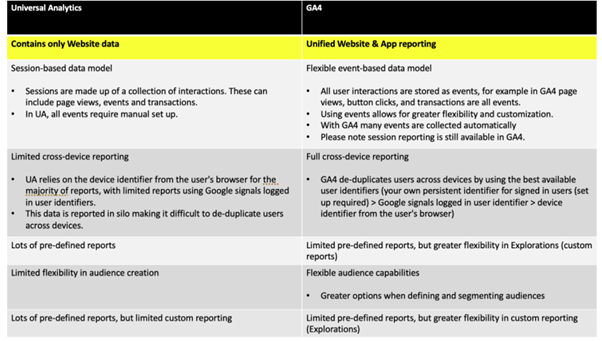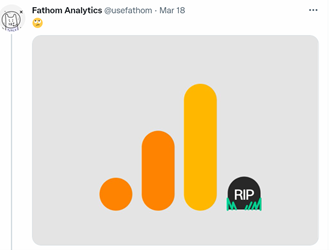Two and a half years ago, Google Analytics 4 was introduced to us, and we have consequently been drip-fed information about how it's being shaped to 'address evolving measurement standards and help businesses succeed'. On the 16th March, Google made their most important announcement to date, with the news that Universal Analytics will begin sunsetting in 2023.
The past couple of years have thrown a lot at us, haven’t they? It would be really nice to have some stability, some sense of returning to ‘normality’.
Even in the world of digital marketing where nothing seems to stand still for too long, it is always reassuring to have the reliables, the constants, the comfort blanket of a system we know like the back of our hand and that serves us very well indeed, thank you very much.
For most of us that tool is good old Google Analytics. The version we’ve all come to know is Universal Analytics (UA), version 3 of Google Analytics. Solid, dependable, familiar. Perhaps beloved is a step too far, but for ten years, it has done the job we needed it to.

Then in late 2020, Google unleashed Google Analytics 4 (GA4) with promises of predictive insights, deeper integration with Google Ads and cross-device measurement capabilities. We attempted to get to grips with it early on and found it baffling to say the least. Never mind though, this was just the beta version, and that’s what Google does right? Release something then improve it over time and in due course they’d iron out the flaws and reinstate the UA tools that should never have been omitted in the first place….right?
Wrong.
So how did we end up here? Let’s backtrack for a second and look at why we use Google Analytics and how it all started.
Google & Urchin Analytics
In the very early days of web-building at Adido we used something called Log file Analysers - these were to ascertain very basic info such as number of hits (remember those?!) and where those hits were coming from. If I can put my rose tinted glasses on for a second, the days of just having AWStats were a much simpler time. And judging by the website, they don’t seem to have ever left those days…

Then in 2005, as the first version of the web was starting to mature, Google purchased a web statistics analysis program called Urchin, rebadged it and...Google Analytics was born. (It’s the reason we still have UA-xxxxxx ID numbers still). The platform was tweaked and then pushed out free of charge thereby creating the first free large-scale web analytics tool. Not only that, the way it worked and the data it gave us, was pretty game changing.
Within a week of its launch, over 100,000 new accounts had been activated, so Google had to suspend new sign-ups for almost a year while they frantically worked out a way to expand the infrastructure and subsequently support the huge global demand.
In 2012, Google Analytics evolved into Universal Analytics and this is the version that has been/is used by website owners across the globe, including us here at Adido. Over the past decade, I have promoted and pushed UA as the single most important tool clients should have on their websites - it does the job and it does the job well. I’m not alone in this opinion. Shortly after its release in 2012, UA was used by 55% of the 10,000 most popular websites. A year later in August 2013, that had gone up to 66.2%.
This data proved incredibly useful not only to website users, but also Google. They owned the data collected and I’m of absolutely no doubt that this data helped them shape their algorithm and search results for the better for a long time. By seeing how users behaved post the search click, they could then feed this back into their quality metrics to help better sites climb the rankings, while demoting those that tried to scam users or rankings.
GA4 is NOT an upgrade! It’s a new approach
So when GA4 was introduced, we were wary but initially assumed it would be simple upgrade of UA. Our initial impression was that it didn’t seem fit for purpose. Many of the existing metrics, screens that we were used to, had largely disappeared. This wasn’t just an upgrade, it was an entirely different tool but one that would evolve over time to get nearer to what we were used to, right?
Nearly two years’ on, we’ve realised that’s not the case. GA4 is NOT the next version of Google Analytics – it is something different. We recently had the pleasure of welcoming Jill Quick, Analytics Consultant at The Colouring In Department, to train our team on GA4. She uses the analogy of modes of transport to explain the evolution of Analytics:

‘GA4 is the 4th version of GA and it is nothing like a car, this upgrade is so different, this vehicle is not even on the road anymore. It is a helicopter, and we all need to learn how to fly one! We all need to learn how to fly a GA4 “helicopter”.’
So what are the main changes?
One big change is that GA4 can track a website and an app in the same account. Previously, there was no simple way of merging mobile app and site data, but with GA4 the user is able to integrate this data into a single GA property making it better for cross-device and cross-platform tracking. This is useful for some bigger website and app owners out there for sure, but not for a large chunk of website owners.
Unlike GA3, GA4 requires significant configuration for the data to have any meaningful use. Whilst many, like us back in 2020, will click the ‘upgrade button’, apply the tracking code via GTM, and wait for the data to roll in ready to analyse, I’m afraid it’s not that simple. From setting up data streams, to amending property settings, and selecting enhanced measurement fields there are a whole host of configuration actions and new terminology to get to grips with. Not to mention being aware of default settings which can make or break long term analysis!
There are also several new reporting features which have replaced some of UA’s standard metrics. Bounce rates, for instance, have been dropped, with GA favouring ‘engaged sessions’ instead. All interactions – or events – will be tied to the user rather than the session. This itself is a very different approach to looking at data and website visitors and one we’ll all take a while to get our heads around.
‘Universal Analytics was built for a generation of online measurement that was anchored in the desktop web, independent sessions and more easily observable data from cookies. This measurement methodology is quickly becoming obsolete’.
Speaking of cookies, the other big change is around GDPR and privacy laws. When GDPR came into force in 2018, Google had to scruitinise how personal data held on its servers is collected and processed to avoid substantial penalties. GA4 will track users privately and anonymously to avoid falling foul of the new laws.
A more comprehensive table of differences is shown below:

Change for the better?
We have a lot of concerns around GA4 and we’re certainly not alone. Just type #GA4 into Twitter and you’ll be treated to howls of condemnation, frustration and even the odd shedding of tears.

We were under the impression GA4 would run alongside UA for a few years before the latter would gradually be phased out. Perhaps there was a glimmer of hope that GA4 would just slip away and be quietly put to bed, filed under ‘What Were We Thinking?’ like many other Google products.
However, our worst fears came true recently with announcement that Google will be sunsetting UA on 1st July 2023. From that date, NO new data will be collected using Universal Analytics, and it won’t keep our data to look backwards for much longer either.
GA4 is go to be the default from Google whether we like it or not, and we only have just over a year to complete the transition. Sigh.
Why Google Analytics 4 now?
So, the question is: Why now? After nearly two years in beta, and seemingly no one in the world wanting to use it, why is Google content to let so many users potentially jump ship? Here are my thoughts:
1. Quite simply, they have too many websites using their resources and Google doesn’t really want or need low value websites clogging up its data centres. It is evident Google has switched its focus to higher value websites, hence why GA4 appears to have been set up with larger companies in mind (ones with inhouse teams of analysts at their disposal where the technical challenges can be met far easier than most SMEs can handle).
2. These higher value websites may potentially end up being charged to use GA4 in the future. To get any juicy data from GA4, you need to use BigQuery which is currently free for the query levels most businesses will need – for now. While Google has kept schtum on this subject you could see how this would be a nice little revenue stream for them in the future if they get just a few million websites paying a fiver a month.
3. GDPR – as mentioned earlier, Universal Analytics has been around for a decade. We’ve seen so many examples of poor configurations which have captured email address, names, phone numbers and everything else. Google will have a LOT of data in its servers that will fall foul of current data laws which it will only be too happy to bin off.
4. Google just feels it’s time for a change. Ten years is a long old time in tech and they will obviously want to keep one step ahead. Yes, the changes around how cookies are used are necessary (although they themselves are bringing them in), and the cross-device function is a game-changer, but it’s hard to understand why these features couldn’t have been potentially integrated into the existing analytics system as opposed to changing the whole system altogether.
Do I Need Google Analytics 4?
The answer to that really depends on what you use GA for and how much you rely on Google Ads and SEO for your business. For some clients, *not* switching to GA4 may be the right decision due to its complexity and the time and effort involved in setting things up. Simpler to use tools are out there and can do what needs to be done just as effectively.
And while Google has the monopoly, it is not the only analytics platform out there. Here are just a handful of ones we’re looking into:
No doubt they've all seen an influx in new clients in light of the news of ‘old’ GA shutting it doors and they are only too happy to welcome more. And I like it that they’re not above taking the odd swipe at Google either!

And this is where Adido can help. We’re on this journey together with our clients and will always be on hand to advise what is best for you and your website. Over the next few months, we’ll be sharing blogs to giver further insights and update clients on our learnings. Yes, this may be a steep learning curve, but we’ll get there!




